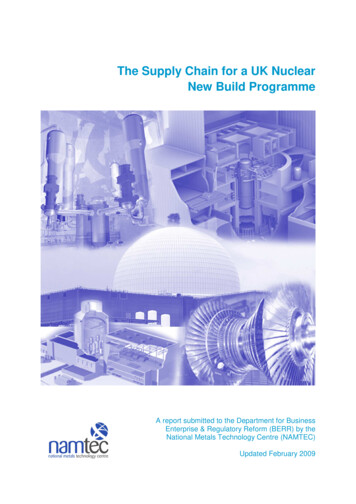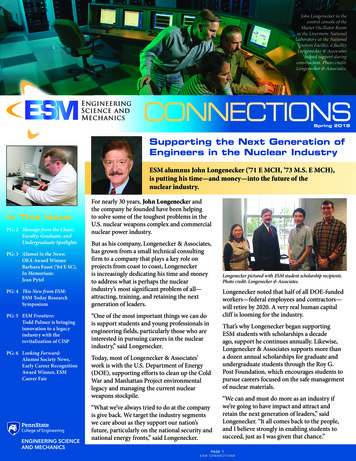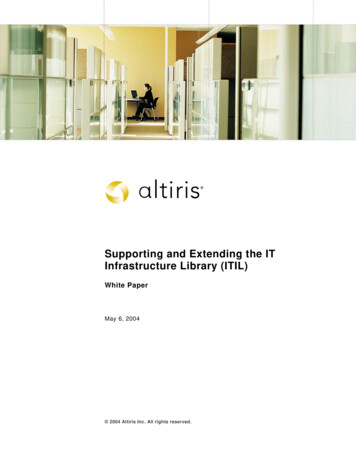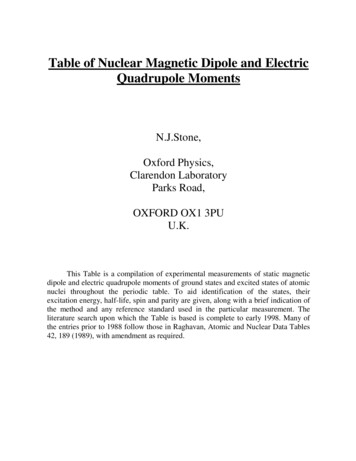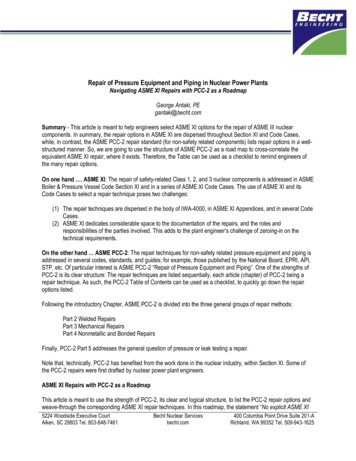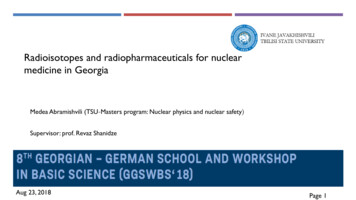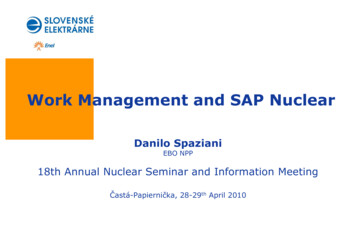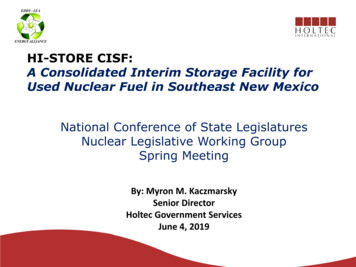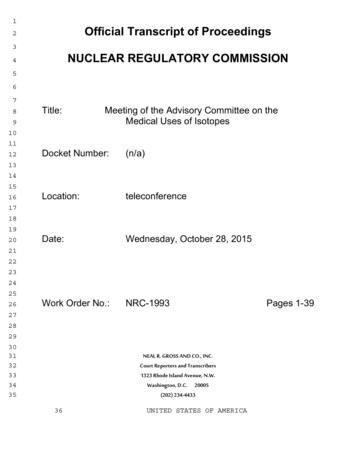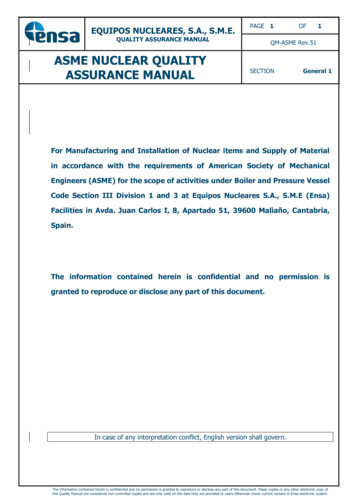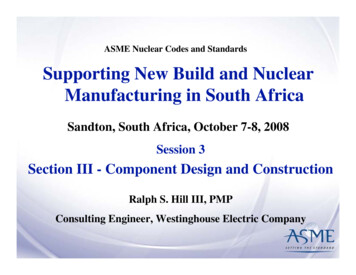
Transcription
ASME Nuclear Codes and StandardsSupporting New Build and NuclearManufacturing in South AfricaSandton, South Africa, October 7-8, 2008Session 3Section III - Component Design and ConstructionRalph S. Hill III, PMPConsulting Engineer, Westinghouse Electric Company
Today’s Agenda1.2.3.4.5.6.Small Advertisement for the ASME CodeStructure and Use of Section IIICode Interpretations and Code CasesBasic Terms & Important ConceptsSubsections of Section IIIAppendices
ASME Code Usage60 Countries – ASME B&PV Code15 Countries –Section III/XI Nuclear Code20 Countries – Section III Certificate Holders30 Countries purchase items to Section III/XI
Trend for Boiler Explosions in the U.S.5000 psi1600 psi400 psi650 psi500 psiPRESSURE LEVEL
Today’s Agenda1. Small Advertisement for the ASME Code2. Structure and Use of Section III3.4.5.6.Code Interpretations and Code CasesBasic Terms & Important ConceptsSubsections of Section IIIAppendices
ASME Section III, Div. 1– 8 Subsections NCA: General RequirementsNB: Class 1 ComponentsNC: Class 2 ComponentsND: Class 3 ComponentsNE: Class MC ComponentsNF: SupportsNG: Core Support StructuresNH: Class 1 Components in Elevated Temp.Service– Appendices– Code Cases Nuclear Components
Component ClassificationClass 1Components (III, Subsection NB)Those components that are part of the primary corecooling systemComponents (III, Subsection NH)Those components that are used in elevated temperatureserviceClass 2Components (III, Subsection NC)Those components that are part of various important-tosafety emergency core cooling systemsClass 3Components (III, Subsection ND)Those components that are part of the various systemsneeded for plant operation
Section III Subsection Organization“construction” tingoverpressure protectioncertificationorganization X-8000
NCA-1140 Use of CodeEditions and Addenda(a)(1) Under the rules of Section III, the Owner or hisdesignee shall establish the Code Edition andAddenda to be included in the Design Specifications.All items of a nuclear power plant may beconstructed to a single Code Edition and Addenda, oreach item may be constructed to individuallyspecified Code Editions and Addenda.
NCA-1140 Use of CodeEditions and Addenda(a)(2) In no case shall the Code Edition and Addendadates established in the Design Specifications beearlier than:(a) 3 years prior to the date that the nuclearpower plant construction permit application isdocketed; or(b) The latest edition and addenda endorsed bythe regulatory authority having jurisdiction at theplant site at the time the construction permitapplication is docketed.
Today’s Agenda1. Small Advertisement for the ASME Code2. Structure and Use of Section III3. Code Interpretations and CodeCases4. Basic Terms & Important Concepts5. Subsections of Section III6. Appendices
Code Interpretations Provide answers to questions about theCode Anyone can request– Appendix XX provides instructions Are published in the Code so answersare available to everyone
Inquiry on Code Edition and Addenda10CFR52 Design Certification Process Regulator may have approved Edition andAddenda earlier than latest endorsed byregulator at time Combined LicenseApplication is docketed Regulator may have approved Edition andAddenda from the Design CertificationDocument at time Combined LicenseApplication is docketed
Inquiry on Code Edition and AddendaInquiry: As described in NCA-1140(a)(2)(b), does“the endorsement of the latest Code Edition andAddenda by the regulatory authority at the timethe construction permit is docketed” include theCode Edition and Addenda endorsed by theregulator through the design certification processand included in the combined operating license(COL) at the time the COL is docketed?Proposed Reply: Yes.
NCA-1140AccompanyingCode Change
Code CasesProvide: Relief from an existing Code requirement Treatment of topics not currently addressedAre: Permissive, not mandatory Issued periodically by Code Committee
NCA-1140Code Case
Regulatory Approval of Code Cases
Other Code Case Regulatory Guides Regulatory Guide 1.147 lists Code CaseAcceptability for Section XI, In-ServiceInspection Regulatory. Guide 1.192 lists the Operationand Maintenance Code Case Acceptability. Unendorsed Code Cases are listed inRegulatory Guide 1.193
Today’s Agenda1. Small Advertisement for the ASME Code2. Structure and Use of Section III3. Basic Terms & Important Concepts4. Subsections of Section III5. Appendices6. Code Cases
Basic Definitions Material Component
Section III Material Requirements Material Specification– Section II: Parts A, B, C, & D Control of Material– Section III: NCA-3800 Special Material Requirements– Section III: NX- 2000
Important Concepts/RequirementsTRACEABILITY Identification– NCA-3856 Identification, Marking, and Material Control– NB-4122 Material Identification Certification of Material– NCA-3861 Certification Requirements for MaterialOrganizations– NCA-3862 Certification of Material– NCA-3862.1 Material Certification– NCA-3862.2 Quality System Program Statement
Important Concepts/Requirements Thermal stresses explicitly considered Basis for stress limits shifted from maximumprincipal stress theory to more accuratemaximum shear stress theory Fatigue recognized as possible failure mode Brittle fracture specifically treated Plastic limit analysis established as a reliablepredictor of ductile failure after some plasticaction
Jurisdictional Boundaries
Jurisdictional Boundaries (Detail)
Today’s Agenda1.2.3.4.5.6.Small Advertisement for the ASME CodeStructure and Use of Section IIICode Interpretations and Code CasesBasic Terms & Important ConceptsSubsections of Section IIIAppendices
Structure of Section III SubsectionsArticle NX-1000Article NX-2000Article NX-3000Article NX-4000Article NX-5000Article NX-6000Article NX-7000Article NX-8000IntroductionMaterialDesignFabrication and InstallationExamination (NDE)Pressure TestingOverpressure ProtectionNameplates, Stamping & Reports
Subsection NB Class 1 ComponentsArticle NB-1000Article NB-2000Article NB-3000Article NB-4000Article NB-5000Article NB-6000Article NB-7000Article NB-8000IntroductionMaterialDesignFabrication and InstallationExamination (NDE)Pressure TestingOverpressure ProtectionNameplates, Stamping & Reports
Article NB-2000 MaterialsNB-2100NB-2200NB-2300NB-2400General Requirements for MaterialMaterial Test Coupons andSpecimens for Ferritic Steel MaterialFracture Toughness RequirementsWelding and Brazing Material
Article NB-2000 Materials (cont.)NB-2500 Examination and Repair ofPressure Retaining Material Plate Forgings and Bars Seamless and Welded Tubular Productsand Fittings Tubular Products and Fittings with FillerMetal Statically & Centrifugally Cast Products Bolts, Studs and Nuts
Article NB-2000 Materials (cont.)NB-2600NB-2700Material Manufacturers’ QualitySystem ProgramDimensional StandardsNB-2160Deterioration of Material– Outside scope of Section III– Covered in Design Specification
Design eneral DesignDesign by AnalysisVessel DesignPump DesignValve DesignPiping Design
NB-3100 General Design Loading Criteria–Loading conditions (pressure, impact loads, weight,reaction, etc.)–Design loadings (design pressure, design temperature anddesign mechanical loadings) Special Considerations–Corrosion–Cladding stresses–Welding (dissimilar welds, fillet weld attachments) External Pressure Analysis
NB-3200 Design by Analysis Design Criteria– Basis for determining stresses (maximum shearstress theory)– Terms relating to stress analysis– Stress classification– Derivation of stress intensities
NB-3200 Design By Analysis (cont.)Stress LimitPrimary (Pm,Pb & P L )Primary plussecondary(P Q)Peak (Sa)SpecialFailure ModePlastic deformation and provide nominalfactor of safety on ductile burst pressureExcessive plastic deformation leading toincremental collapse and validate fatigueevaluation elastic analysisFatigue failure as a result of cyclicloadingsElastic and inelastic instability
NB-3200 Design By Analysis (cont.) Stress Limits for Components–––––– Design Condition LimitsLevel A Service Condition LimitsLevel B Service Condition LimitsLevel C Service Condition LimitsLevel D Service Condition LimitsTest Condition LimitsFatigue Analysis ProcedureThermal Stress RatchettingPlastic AnalysisLimit AnalysisSimplified Elastic Plastic Analysis(Normal)(Upset)(Emergency)(Faulted )
Section III Design by Rule Uses simple equations Sets rules on geometry of construction Uses conservative design values forpressure and temperature Justification is based on allowing only lowstresses combined with “over-design”
NB-3300 Vessel Design General Requirements Design Considerations– Minimum Pressure Thickness Calculations Openings and Reinforcement Design of Welded Construction
NB-3300 Vessel Design
Design, Fabrication &Examination IntegrationNB-3352.1 Joints of Category AAll welded joints of Category A as definedin NB-3351 shall meet the fabricationrequirements of NB-4241 and shall becapable of being examined in accordancewith NB-5210.
Design NC/ND-3500NC/ND-3600General DesignAlternate Design Rules for VesselsVessel DesignPump DesignValve DesignPiping DesignNC/ND-3700 Electrical and MechanicalPenetration AssembliesNC/ND-3800 Atmospheric Storage TanksNC/ND-3900 Storage Tanks 0-15 psig (0-103 kPa)
Fabrication and Installation B-4700General RequirementsForming, Fitting and AligningWelding QualificationsMaking, Examining and Repairing WeldsBrazingHeat TreatmentMechanical Joints
NB-4100 General Requirements Certification of materials Fabrication by certificate holder Repair of materials
NB-4200 Forming Fitting and Aligning Cutting– Material may be cut to shape and sized by mechanicalmeans, such as: Machining Shearing Chipping Grinding Thermal cutting Recommendations for preheating prior to thermalcutting in Appendix D Preheat Procedures
NB-4200 Forming Fitting and Aligning(cont.) Forming and Bending Processes– May be hot or cold provided impact properties are notreduced below specified values– Heat treatment may be used to restore properties Qualification of Forming Processes for ImpactProperty Requirements– Procedure qualification test required– Acceptance standard based on impact properties
NB-4200 Forming Fitting and Aligning
NB-4200 Forming Fitting and Aligning
NB-4200 Forming Fitting and Aligning
NB-4200 Forming Fitting and Aligning
NB-4200 Forming Fitting and Aligning
NB-4300 Welding Qualifications Types of processes permitted Required qualifications Requirements for welding procedure qualificationtests Special qualification requirements for tube-totubesheet welds Qualification requirements for welding speciallydesigned welded seals
NB-4400 Rules Governing Making,Examining and Repairing Welds Precautions before weldingRules for making welded jointsWelding of attachmentsRepair of weld metal defects
NB-4500 thru NB-4700NB-4500 Brazing––––Rules for brazingQualification requirementsFitting and aligningExaminationNB-4600 Heat Treatment––––Welding preheat requirementsPost-weld heat treatment requirementsIntermediate post-weld heat treatmentHeat treatment after bending or forming forpipes, pumps and valves– Heat treatment of electroslag weldsNB-4700 Mechanical Joints
NB-4600 Postweld Heat Treatment
NC/ND-4000 Fabrication and 00NC/ND-4500NC/ND-4600NC/ND-4700General RequirementsForming, Fitting and AligningWelding QualificationsMaking, Examining and Repairing WeldsBrazingHeat TreatmentMechanical JointsNC/ND-4800 Expansion Joints
Examination NB-5000NB-5100NB-5200NB-5300NB-5400NB-5500General RequirementsExamination of WeldsAcceptance StandardsFinal Examination of VesselsQualification and Certificationof NDE Personnel
NB-5000 ExaminationNB-5100General Requirements for Examination– Fabrication (F) Preservice Base Line (PS)NB-5200Required Examination of Welds––––––––Category A Welded Joints (Longitudinal Welds)Category B Welded Joints (Circ Welds)Category C Welded Joints (Flange to Shell, etc.)Category D Welded Joints (Nozzle to vessel, etc.)Fillet, partial penetration and socket weldsStructural attachment weldsSpecial welds (e.g., Canopy Seal Welds)Preservice Examination
NB-5000 Examination (cont.)NB-5300Acceptance raphicUltrasonicMagnetic particleLiquid PenetrantEddy CurrentVisualGas and bubble formation testingFinal Examination of VesselsQualifications and Certification ofNondestructive Examination Personnel
NC/ND-5000 Examination NC/ND-5100 NC/ND-5200 NC/ND-5300 NC/ND-5400 NC/ND-5500 NC/ND-5700General RequirementsExamination of WeldsAcceptance StandardsFinal Examination of ComponentsQualification and Certification ofNDE PersonnelExamination Requirements forExpansion Joints
Testing NB-6000NB-6100NB-6200NB-6300NB-6400NB-6600General RequirementsHydrostatic TestsPneumatic TestsPressure Test GaugeSpecial Test Pressure Situations
NB-6000 Testing
NC/ND-6000 Testing General RequirementsHydrostatic TestsPneumatic TestsPressure TestSpecial Test Pressure Situations NC/ND-6500NC/ND-6900Atmospheric & 0-15 psig Storage TanksProof Tests to Establish Design Pressure
Overpressure Protection -7600NB-7700NB-7800General RequirementsOverpressure Protection ReportRelieving Capacity RequirementsSet pressures of Pressure Relief DevicesOperating and Design Requirements forPressure
20 Countries – Section III Certificate Holders 30 Countries purchase items to Section III/XI. Trend for Boiler Explosions in the U.S. 400 psi 500 psi 650 psi 1600 psi 5000 psi P R E S S U R E L E V E L. Today’s Agenda 1. Small Advertisement for the ASME Code 2. Structure and Use of Section III 3. Code Interpretations and Code Cases 4. Basic Terms & Important Concepts 5. Subsections of .
